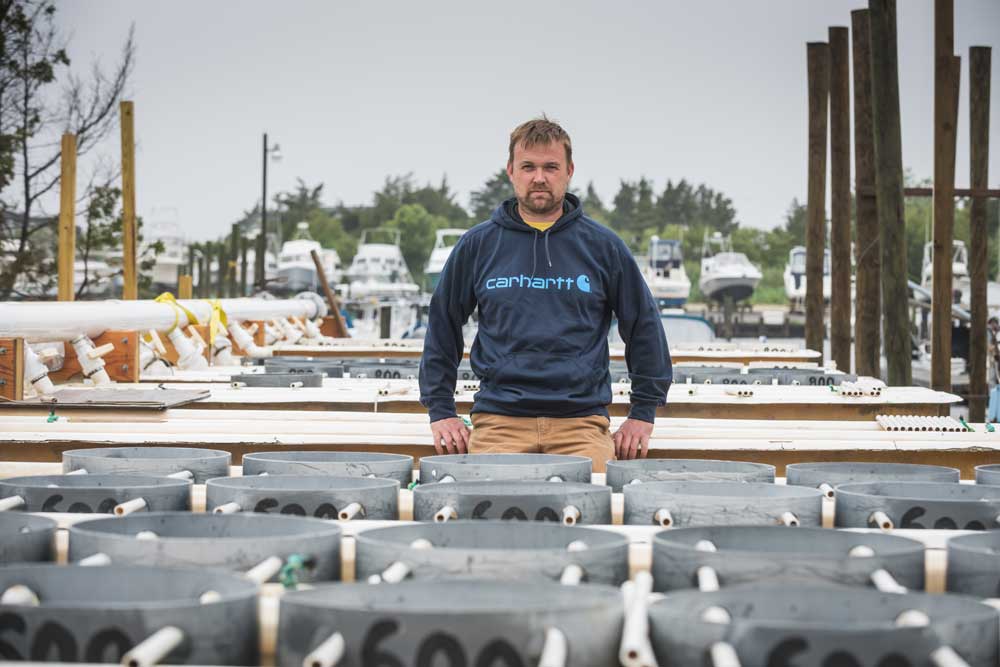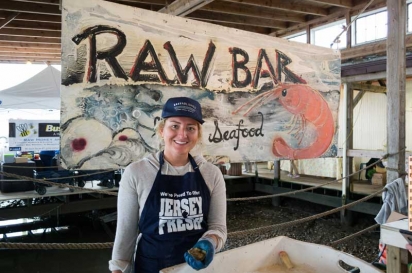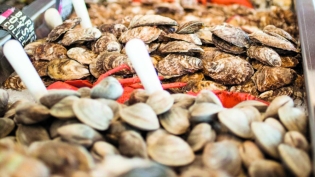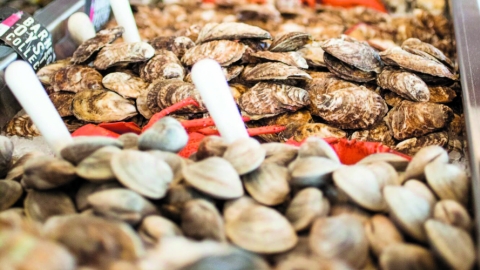OYSTER INNOVATION: BUILDING REEFS, BUSINESS AND COMMUNITY
Oyster habitats crucial to the ecosystem
When fifth-generation bayman Dale Parsons Jr. thinks about the reef he’s building in Little Egg Harbor Bay, he thinks about his 3-year-old daughter. What kind of environment will he leave for her? What will the family business look like, should she take it on? Certainly, the Parsons family, whose work on these waters dates to 1909, has seen its share of changes.
“All of Barnegat Bay was productive at one time,” Parsons says. “You could take a shell and put it anywhere and oysters would attach to it.” In time, overharvesting, disease and development took a toll. Then beach-replenishment projects delivered a critical blow, filling inlets with sand and obstructing the intertidal flow—a dance between ocean and bay that’s critical to shellfish.
Here’s why: Less flow means decreased salinity, which in turn encourages blooms of macro-algae, a species much larger than the phytoplankton that shellfish eat. Without an intertidal flushing effect, most of that macro-algae settles to the bottom. As temperatures rise and the micro-algae decays, it chokes out the shellfish that live in the benthic zone, the lowermost level of the bay where the bottom and the water meet.
Baymen call it the black death.
“The bay went through a biological change,” Parsons explains. “Areas of the bay are becoming shallow. There’s not enough turbidity to keep macro-algae in suspension and get it out to the ocean.” That’s a big problem. When the waterways are healthy, so too are the bivalves. When the waterways are not healthy, the bivalves follow suit.
Oysters are a keystone species, meaning that their survival is a litmus test of whether an ecological system is in balance. A natural oyster reef, which is a collection of living oysters and oyster shells, is an essential habitat. When waters aren’t conducive to oysters, the reefs in which they live disappear. In turn, species that depend on the oysters for food and their reefs for habitat die off as well, from bay scallops to juvenile fin fish.
About 10 years ago, Parsons started considering whether he could do something about it.
A Research Reef is Born
Steve Evert, manager of Stockton University’s Marine Field Station, remembers those days well. He was managing a state-run spat-fall monitoring program, working with students to assess whether oyster larvae adrift in the bay (a.k.a. spat) were able to successfully attach, or “set,” to clean shells. Once they move in, oysters remain in place forever, and begin to grow shells of their own. In time, this interconnected gathering creates a reef. By tracking how many make that connection, scientists have a barometer for the system’s health, which can influence better resource management.
On the bay, Evert and Parsons had both noticed something: a still small, but increasing number of wild oysters setting in the bay. The question was, why? Initially, the two wondered whether there were great numbers of larval oysters in the bay, but insufficient reef or hard surfaces on which they could grow. Likely not. “There are probably not enough larvae in the water column to just put down boatloads of shell and think that you’re going to create a reef,” Evert says. “So, the only way to do it is to start jumpstarting that population.”
The Little Egg Harbor research reef was born.
Backed by a grant from the Barnegat Bay Partnership, the pair started building two key program components: expansion of the hatchery where Parsons can grow oyster seed and set it to shell, and a small reef on a 2-acre lease. In time, they hope it will become the impetus for large-scale restoration. So far, so promising.
“The lease made it through its first year, and it looks pretty good,” Evert says. “If it makes it into year two, and into year three, we have the right data to argue for bigger restoration money.”
His big-picture vision? “I’ll probably work for another 20 years. I would like to think by the end of that, there will be a self-recruiting, reasonably sized reef in Little Egg Harbor Bay.” That would be a major restoration milestone, and one he would love to see paired with the eventual opening of limited public harvest, which exists today only for clams. Back in the day when the system was thriving, vacationers and locals could harvest oysters and serve them up for dinner. If the restoration work continues in the right direction, Evert is optimistic that such a program could return.
While Stockton-backed grant funding offset some initial project costs, Evert says none of that long-term potential would be there without Parsons’ personal investment of time, capital and labor. All told, Parsons estimates that he has invested about $30,000 of his own capital into infrastructure for the project, not to mention great amounts of personal labor and planning time. “I would do it again,” he says, noting an appreciation that data collection is coming from an academic source. “It’s non-biased, and if it’s a success, it’s a proof of concept that needed to happen for the bay.”
If things continue to go well, that may just pay off. “Restoration can’t happen without an aquaculturist and an aquaculture facility, and Dale is situated to be able to respond to that,” Evert says. Given recent developments, that demand may be cropping up sooner rather than later.
LBI Launches Innovative Plan to Recycle Shells
For the last two years, Evert was the collector-in-chief for the shell-recycling program at The Old Causeway restaurant, gathering them, and delivering them to Parsons’ facility for curing before their eventual trip to the reef—hopefully with baby oysters along for the ride. (See page 36, “Healthy Bay, Healthy Market”) This summer, that program is getting a major boost, with the phase-one launch of an island-wide shell-recycling program.
It includes major buy-in from two key players: Long Beach Township and the Jetty Rock Foundation.
Long Beach Township is already among the state’s few municipalities with a sustainability coordinator, who just so happens to be filmmaker Angela Andersen, producer of an oyster documentary. (See page 48, “The Oyster Farmers”) As the township commits to shell recycling—bringing eight or nine restaurants on board, hiring a shell collector and buying a truck for transport to Parsons for curing—she has a sense of her worlds colliding. “Putting the resources of our recycling program behind the program, and becoming the model is extraordinary,” she says, applauding Mayor Joe Mancini’s vision. “I’m humbled by that.”
In the past, discarded oyster shells ended up in the landfill, which costs the township $72 a ton. Through this program, participating restaurants will have up to four shell-recycling baskets out back, each of which weighs 40 pounds full. As diners discard shells, they learn about the reef-restoration project, while directly contributing, one order at a time. “If you start calculating the weight of these shells, especially after a buck-a-shuck night, that’s a lot of money not being sent to the landfill.”
The model also ties right back into the theme that underscores the film, she says: following the shell. “People are introduced to oysters sitting at a raw bar and seeing it on a plate of ice.” With education happening tableside, a bigger story can be shared, and the public can be rallied to reconnect to local food while getting behind the vision of Parsons and Evert. “The oyster is the ultimate recycler. You can’t get any purer than that.”
“Long Beach Township has taken the bull by the horns,” Parsons says, inspired by a brainstorming meeting with Mayor Mancini where the two mapped out a vision for public engagement.
Director of The Oyster Farmers Corinne Ruff likens it to an ouroboros, the snake swallowing its tail. “When we put the oyster shells back in the bay and not in a landfill, the oyster spat have a place to land and grow in their forever home, the reef. As adults, they filter 50 gallons of water a day, removing nitrogen and algae from the water. By filtering the water, they allow more sunlight in, which helps subaquatic vegetation, critical to marine life, to grow. Returning the shell to the bay helps the system heal itself. Total circle of life.”
For the Jetty Rock Foundation, which made waves as a local champion after Hurricane Sandy, that makes getting involved a no-brainer. CEO Jeremy DeFilippis says the project will be a major initiative for his organization moving forward. “Seeing the nursery and what Dale built, you simply can’t leave that experience and not be incredibly excited and intrigued,” he says. “We can tap into the people. We can tap into the businesses, municipalities, grants and non-profits. There’s no reason we can’t all work together to get the bay the way it was 100 years ago.”
In time, DeFilippis hopes to tie the reef into Jetty Rock’s existing education programs with local schools. “Jetty would love to base full semesters or classes on the reef, oysters in the bay and everything that revolves around that.”
To be clear, the existing reef alone won’t restore a system as large as the Barnegat Bay. It’s a first step. But Parsons believes every little bit helps. “When we take shellfish, and put it in the bay, we’re correcting where we’ve made a mistake. My family has been earning a living from this water for over a hundred years, and this is an opportunity for me to bring it back.”
His hope is that with an engaged public, and lots of new shell, the momentum will take on a life of its own. This includes more restaurants coming on board to recycle, students and locals reconnecting to the waterways and everyone playing their part in supporting what could become an even-larger restoration project if that federal funding someday comes through.
“It’s a lot like what the oyster does,” Parsons reflects. “Each oyster is contributing that little piece to the value of the ecosystem. Every person who contributes to that program can be their own oyster for the bay.”
Parsons Seafood
468 S. Green St., Tuckerton
609.296.2061 facebook.com/Parsons-Seafood-298108572736








